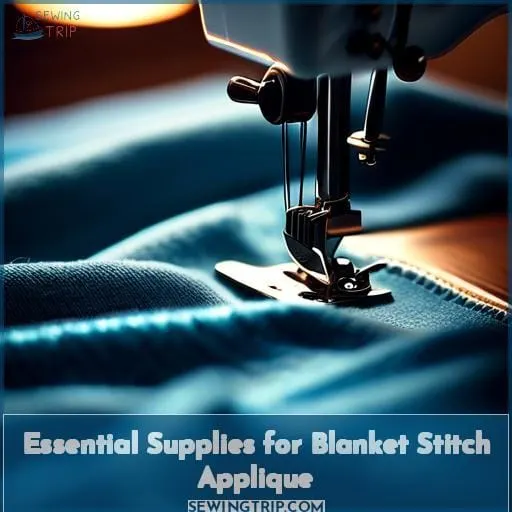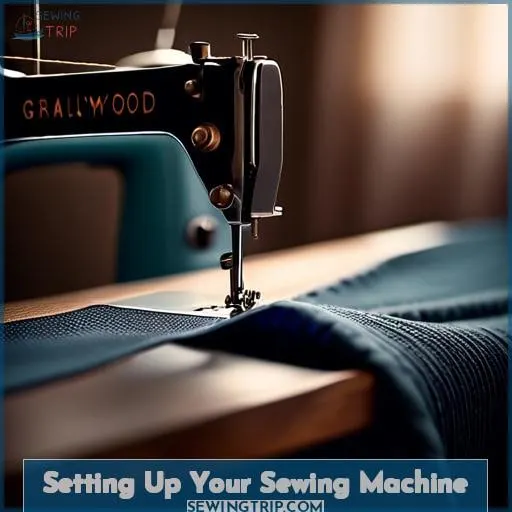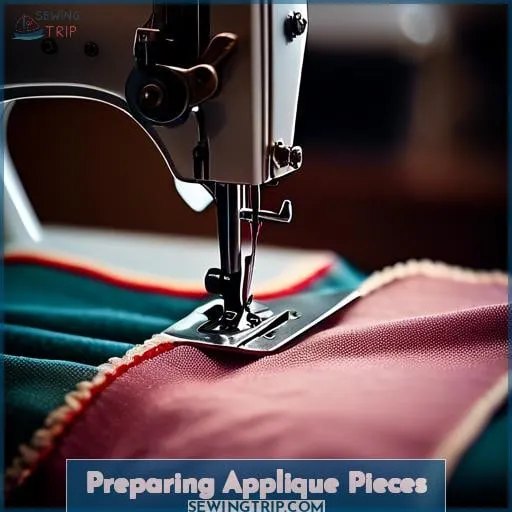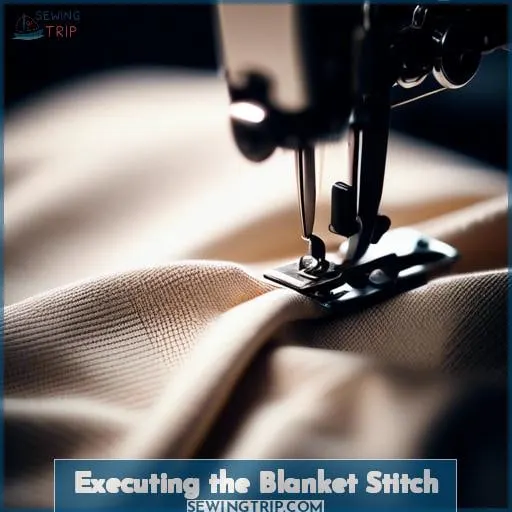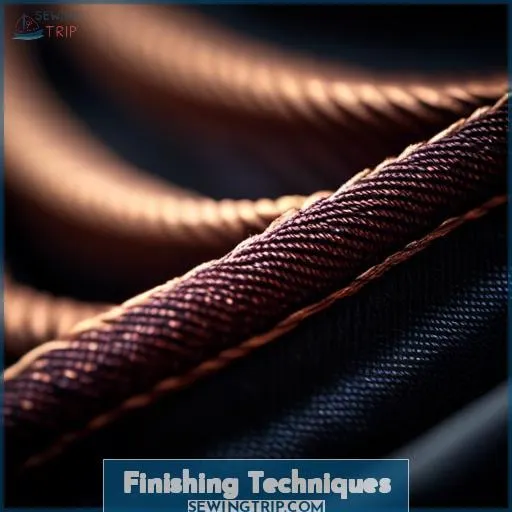This site is supported by our readers. We may earn a commission, at no cost to you, if you purchase through links.
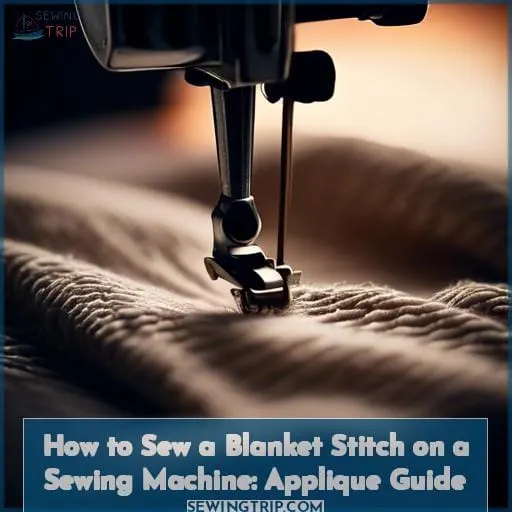 Embarking on the journey of mastering the blanket stitch on your sewing machine can transform your applique projects from simple to spectacular. This guide dives into the essentials, from selecting the perfect thread and stabilizer to adjusting your machine for that flawless finish.
Embarking on the journey of mastering the blanket stitch on your sewing machine can transform your applique projects from simple to spectacular. This guide dives into the essentials, from selecting the perfect thread and stabilizer to adjusting your machine for that flawless finish.
You’ll learn to prepare your applique pieces with precision, ensuring they’re ready to be adorned with the decorative and durable blanket stitch. Whether you’re enhancing the edges of your applique with contrasting thread for a pop of color or aiming for a subtle, refined finish, this tutorial equips you with the skills to elevate your sewing projects.
Let’s unravel the secrets to executing the perfect blanket stitch on your sewing machine, turning your applique visions into reality.
Adjust your machine:
Select the right thread: Choose a thread that complements your fabric and design.
Use stabilizer: Apply a stabilizer to prevent the fabric from stretching or puckering.
Adjust stitch length and width: Set the stitch length and width according to your preference.
Prepare your applique pieces:
Cut the applique fabric: Cut the fabric into the desired shape.
Position the applique: Place the applique on the base fabric.
Pin or glue the applique: Secure the applique in place.
Execute the blanket stitch:
Start stitching: Begin stitching at the edge of the applique.
Adjust the needle position: Move the needle to the left or right for better control.
Stitch around the applique: Stitch around the edge of the applique, maintaining consistent stitch length and width.
Finish the stitch: End the stitch at the starting point.
With these steps, you can execute the perfect blanket stitch on your sewing machine, elevating your applique projects to new heights.
Yes, you can sew a blanket stitch on a sewing machine by selecting the stitch, adjusting the length to 0.
Table Of Contents
Key Takeaways
- Adjust the thread tension on your sewing machine to ensure the blanket stitch is formed correctly and to prevent puckering or loose seams.
- Experiment with different stitch widths (2.0-4.
- And lengths (0.2-0.
- To find the best setting for your project, and use a permanent pen to record these settings for future reference.
- When executing the blanket stitch, start at the edge of the appliqué, pivot at curves and points, and adjust the needle position to ensure the stitch encases the edge of the appliqué properly.
- To finish the blanket stitch neatly, secure thread ends by pulling them to the back and knotting off, and trim excess fabric to prevent fraying.
Essential Supplies for Blanket Stitch Applique
To kick off your journey into blanket stitch applique, you’ll need a few key supplies.
Grab some muslin fabric, a stabilizer, and contrasting thread to start.
Don’t forget your open toe applique foot and a permanent pen for precision.
With these essentials, you’re well on your way to mastering this decorative technique.
Muslin Fabric, Stabilizer, Contrasting Thread
You’ll need to gather your essentials before diving into the world of blanket stitch applique. Think of it as setting the stage for a performance where precision meets creativity.
- Choosing Fabric: Muslin fabric is your trusty sidekick, providing a smooth canvas for your stitches to shine.
- Selecting Stabilizer: A stabilizer like Pellon Stitch and Tear will be the backbone, ensuring your fabric doesn’t dance away with every stitch.
- Thread Tension: Grab a contrasting thread that’s ready to pop against your fabric, and make sure your tension is just right – not too tight, not too loose, like a perfect handshake.
Now, let’s talk needle type and stitch length. You’ll want a sharp needle, perhaps an 80/12, to pierce through with ease. As for the stitch length, think of it as the rhythm of your sewing melody – set it just above zero for those zigs and zags to lay parallel without crowding each other.
Open Toe Applique Foot, Permanent Pen
You’ll need an open toe applique foot and a permanent pen for precision in blanket stitch applique. The open toe applique foot enhances visibility, ensuring your stitches are exactly where they need to be—hugging the edge of your applique fabric with finesse.
Meanwhile, the permanent pen is your trusty sidekick for marking bobbin dots and plotting your stitch journey with confidence.
| Open Toe Applique Foot | Permanent Pen | Purpose |
|---|---|---|
| Enhances visibility | Marks fabric | Essential for precise applique work |
| Allows for accurate stitch placement | Permanent on fabric | Useful for plotting stitch paths and bobbin dots |
| Ideal for blanket stitch applique | Aids in tension setting | Ensures stitches are anchored properly |
| Helps with point execution | Assists in stabilizer placement | Keeps fabric and stabilizer aligned |
| Compatible with various sewing machines | Essential for turned applique | Marks the fabric before turning |
50 Wt., 3-ply Cotton, DMC Machine Embroidery Thread
When diving into the world of appliqué and decorative stitching, your thread choice is like picking the perfect spice for a gourmet dish—it can make all the difference.
Enter the 50 wt., 3-ply cotton DMC machine embroidery thread, a choice that’s as versatile as it’s vibrant. This thread isn’t just a strand; it’s your ticket to creating embroidered designs that pop and blanket stitches that sing on your sewing machine.
Whether you’re laying down a satin stitch smoother than a jazz solo or zig-zagging around an appliqué with the precision of a tightrope walker, this thread plays well with others, allowing for color mixing that can elevate your project from good to gallery-worthy.
And let’s not forget about machine compatibility; this thread is like the universal remote of the sewing world, ready to work harmoniously with your machine to produce stunning results.
So, thread up, and let’s make your sewing machine sing a new tune with every stitch.
Pellon Stitch and Tear Stabilizer
After threading your machine with 50 wt., 3-ply cotton DMC embroidery thread, it’s time to consider your stabilizer options. Pellon Stitch and Tear stabilizer is your go-to for a tear-away option that supports your fabric during the stitching process.
It’s perfect for applique work, providing a sturdy backing that you can easily remove by tearing it away, without leaving any residue. This type of stabilizer is especially useful for designs with a stitch repeat pattern, as it maintains the fabric’s tension settings, ensuring your stitches lay flat and even.
When working with fusible applique or raw edge applique, the stabilizer’s role becomes even more crucial. It prevents the fabric from puckering and helps to achieve a clean, professional finish. If you’re aiming for invisible stitches, consider using monofilament thread with a narrow zigzag stitch, which can be easily hidden against the fabric.
Setting Up Your Sewing Machine
To set up your sewing machine for blanket stitch applique, it’s crucial to adjust the thread tension and select the appropriate stitch and settings.
Ensure you’re using an open toe applique foot for better visibility, and adjust your zigzag stitch to 3 mm wide with the stitch length just above zero for optimal results.
Adjust Thread Tension, Select Stitch and Settings
To set up your sewing machine for blanket stitch applique, you’ll need to adjust a few settings to ensure your stitches come out just right.
- Stitch Types: Choose the blanket stitch setting on your machine. If you have multiple options, select one that creates a stitch with the bite going to the left.
- Stitch Widths and Lengths: Begin with a default stitch width of around 2.0 to 3.0 mm and a length just above zero, so your stitches lay parallel without overlapping.
- Needle Placement: Ensure your needle is in the down position by default, which helps when pivoting at corners and points.
- Fabric Tension: Adjust the thread tension if necessary. You might start with the auto setting and then tweak as needed based on your fabric and thread ply.
Use an Open Toe Applique Foot for Visibility
To sew a blanket stitch on a sewing machine effectively, it’s crucial to use an open toe applique foot for enhanced visibility. This foot allows you to see precisely where the needle enters the fabric, ensuring your appliques, threads, and patterns align perfectly.
Adjusting the needle size and sewing speed can further refine your technique. When starting and ending threads, bring the bobbin thread up and secure it with a few short stitches to prevent unraveling.
| Aspect | Detail | Note |
|---|---|---|
| Open Toe Foot | Increases visibility | Essential for precision in applique |
| Thread Management | Pull bobbin thread up | Ensures a clean start and finish |
| Machine Settings | Adjust needle size & speed | Tailor to the fabric and applique |
| Stabilizers | Use as needed | Provides stability to the fabric |
| Patterns | Align with needle swings | Ensures accurate stitch placement |
Set Zigzag Stitch to 3 Mm Wide, Stitch Length Just Above Zero
To sew a blanket stitch on a sewing machine, you’ll need to set up your machine correctly.
Zigzag Width: Set your zigzag stitch to a width of 3 mm. This width is ideal for creating the look of a hand-sewn blanket stitch while using a machine.
Stitch Length: Adjust the stitch length to just above zero. This setting will ensure that your stitches are close together, which is characteristic of a traditional blanket stitch.
Bobbin Thread: Make sure your bobbin thread is properly threaded. If you’re using a different weight thread in the bobbin, it could affect the appearance of your stitches.
Starting Point: Begin your stitching at a point that isn’t too noticeable, such as a sharp point or hidden area. This will make it easier to conceal the start of your stitching.
Pivot Point: When you reach a curve or corner, pivot your fabric with the needle down in the fabric to maintain a smooth and even stitch.
Preparing Applique Pieces
Before you start sewing, you’ll need to prepare your applique pieces.
First, use fusible web to bond your cutout shapes to the base fabric, ensuring they stay in place during stitching.
Then, attach a stabilizer like Pellon Stitch and Tear to prevent the fabric from shifting and to support the stitches.
Finally, bring the bobbin thread up to the top of your work to anchor the beginning of your stitches securely.
Create Applique With Fusible Web
To create applique with fusible web, you’ll need to select the right type of fusible web for your fabric choice, ensuring proper adhesion and stability. Begin by placing the fusible web on the wrong side of your fabric, with the rough side of the web facing down.
Iron the fusible web to the fabric, following the manufacturer’s instructions for heat settings and duration to achieve a secure bond. Once cooled, peel off the paper backing, position your applique on the base fabric, and iron again to fuse the pieces together.
Use an open toe foot or walking foot on your sewing machine to blanket stitch around the edges of the applique, which will secure it in place and add a decorative finish. Remember to pivot at corners and curves to maintain a smooth edge. For added durability, you can use a pre-set locking stitch at the start and end of your sewing.
Here’s a quick table to summarize the key steps:
| Step | Description | Tip |
|---|---|---|
| 1 | Select fusible web | Choose the right weight for your fabric |
| 2 | Iron fusible web to fabric | Follow manufacturer’s heat settings |
| 3 | Peel and position applique | Ensure edges are aligned properly |
| 4 | Fuse applique to base fabric | Iron again to bond layers |
| 5 | Machine blanket stitch | Use open toe foot and pivot at corners |
When working with fusible web, it’s important to consider the weight and type of both the web and the fabric to ensure a successful application. The fusible web should be compatible with the weight of the fabric to prevent issues like fraying or stiffness.
Additionally, proper stabilizer placement can help maintain the fabric’s shape and prevent shifting during the sewing process. Always test a small piece first to ensure the desired result before proceeding with your project.
Attach Stabilizer to Prevent Shifting
To attach a stabilizer and prevent shifting during appliqué, you’ll want to select the right type of stabilizer for your project. A common choice is Pellon Stitch and Tear, which provides support during stitching and can be easily removed afterward.
Begin by applying fusible web to your appliqué shape, ensuring it adheres well to prevent movement. When hooping your fabric, use techniques that keep the fabric taut without stretching it. Choose a thread weight that complements your fabric and stitch type; for appliqué, a 50 wt.
Set your sewing machine to a narrow zigzag stitch, which is less visible and helps secure the appliqué’s edges. The default setting for needle down can aid in pivoting at curves and points, ensuring smooth transitions around pointy ends and along curved lines.
If you’re working with thicker layers or need extra control, consider using a walking foot. Remember to bring the bobbin thread up to start and secure your stitches to prevent unraveling.
Pull Bobbin Thread Up, Anchor With Short, Straight Stitches
To start your applique with precision, you’ll want to pull the bobbin thread up and anchor it with short, straight stitches.
Here’s the trick: hold your needle thread with a bit of sass, like it owes you money. Then, with your other hand, give the handwheel a smooth turn towards you. Watch as the needle dips down and scoops up the bobbin thread like a crane game at the arcade.
Gently tug on the needle thread, and voilà, the bobbin thread should pop up like a groundhog checking for its shadow. Slide both threads under the presser foot, giving them a little tail out the back.
Now you’re set to start with your needle swings and stitch alignment on point. Remember, when you hit a curve or a point, pivot with the grace of a ballerina to keep everything looking sharp.
Executing the Blanket Stitch
To master the blanket stitch on your sewing machine, it’s crucial to align the needle swings precisely with the edges of your applique. This ensures a clean, professional finish, especially when pivoting at curves and points.
Opting for a contrasting thread can add a decorative flair to your project, making your applique stand out beautifully.
Align Needle Swings With Applique Edges
When it comes to mastering machine appliqué, aligning your needle swings with the appliqué edges is a game-changer.
Imagine your needle as a skilled dancer, gracefully pivoting at every curve and point of your appliqué.
Using a contrast thread not only adds a pop of color but also forgives minor slip-ups, making your project look impeccable. Remember, the secret sauce to flawless appliqué is in the pivot—anticipate the curve, lead with confidence, and watch as your creation comes to life with precision and elegance.
Whether you’re navigating the gentle bend of a leaf or the sharp point of a star, your needle alignment and curve management skills will ensure your appliqué stands out. So, let’s thread that needle, embrace the rhythm of the stitch, and turn your appliqué project into a masterpiece.
Pivot at Curves and Points for a Clean Finish
To achieve a flawless finish when executing the blanket stitch on your sewing machine, especially around curves and points, it’s crucial to master the art of pivoting. This technique ensures your appliqué work—whether it’s adorning heart motifs on baby quilts, creating intricate tulip blocks for wall hangings, or adding decorative touches to your projects—looks polished and professional.
- Needle Angles: Adjust the needle’s position carefully as you approach curves and points. This ensures your stitches wrap neatly around the appliqué’s edges.
- Stitch Direction: Be mindful of the stitch direction, especially when navigating around complex shapes. This helps maintain a consistent stitch appearance.
- Tension Adjustment: Proper tension adjustment is vital for smooth stitches. Too tight or too loose tension can distort the fabric and affect stitch quality.
- Bobbin Thread Handling and Stabilizer Choice: Managing the bobbin thread correctly and choosing the right stabilizer can significantly impact the final look of your appliqué. A stabilizer like Pellon Stitch and Tear provides the necessary support for delicate stitches.
Use Contrasting Thread for a Decorative Effect
To achieve a decorative effect with your blanket stitch appliqué, consider using contrast thread that pops against your fabric.
Play around with stitch width and length to find the perfect balance for your project. Remember, the right thread tension is crucial for smooth, straight lines and short straight stitches.
When you’re learning how to sew a blanket stitch on a sewing machine, these details make all the difference in elevating your work from basic to brilliant.
Finishing Techniques
To wrap up your blanket stitch appliqué project with finesse, it’s crucial to secure your thread ends and trim any excess fabric. This not only ensures a neat finish but also prevents fraying, enhancing the durability of your work.
Don’t hesitate to play around with stitch widths and lengths to discover what best complements your design, adding that perfect touch to your masterpiece.
Secure Thread Ends by Pulling to the Back and Knotting Off
When you’re putting the final touches on your appliqué with a blanket stitch, it’s crucial to secure your thread ends to avoid any unravelling mishaps.
Here’s the trick: after your last stitch, pull the thread to the backside of your fabric. Now, it’s time for the knotting technique that’s as easy as tying your shoelaces. Make a small knot close to the fabric’s surface, ensuring it’s snug but not a fabric-puckering titan.
This simple act of knotting is the unsung hero that locks in your hard work, giving your piece that polished, professional look. Remember, these finishing touches aren’t just knots; they’re the guardians of your stitches, ensuring your decorative effects and stitch adjustments stay put through thick and thin.
Trim Excess Fabric to Prevent Fraying
Trimming excess fabric is your secret weapon against fraying, a sneaky little gremlin that loves to nibble at your masterpiece’s edges.
Think of it as giving your appliqué a neat haircut; you’re not just preventing those pesky threads from staging a rebellion, but you’re also setting the stage for a flawless finish.
Dive into thread management like a pro, choosing your starting points with the precision of a chess master. Embrace stitch variations as your palette for creativity, painting curves and corners with the finesse of an artist.
And when it comes to those finishing touches, remember, it’s all in the details. A well-trimmed appliqué isn’t just about avoiding fraying; it’s about elevating your work from good to spectacular.
So, wield your scissors with confidence and let every snip bring you closer to perfection.
Experiment With Stitch Widths and Lengths for Best Results
After trimming away any excess fabric to prevent fraying, it’s time to fine-tune your blanket stitch appliqué.
You’ll want to play around with stitch density, thread color, needle size, fabric weight, and stabilizer choice to get the best results.
Think of your sewing machine as a trusty sidekick in your creative adventures, ready to tackle any challenge with a twist of a dial.
A heavier thread might call for a dance with a larger needle, while a delicate fabric could pair well with a lighter touch on the stitch length.
It’s like finding the perfect seasoning for your favorite dish – a pinch of experimentation can lead to a feast for the eyes.
Frequently Asked Questions (FAQs)
How do I adjust my sewing machine if my blanket stitch is pulling the fabric or creating puckers?
If your blanket stitch is pulling the fabric or creating puckers, try loosening the thread tension for a more relaxed stitch.
Also, ensure you’re using a sharp needle and let the feed dogs guide the fabric without interference.
Can I use a blanket stitch for joining two pieces of fabric edge-to-edge, and if so, how?
Imagine you’re a tailor in a magical world, where your needle is your wand and the fabric your canvas. You’re tasked with a unique challenge: joining two pieces of fabric edge-to-edge, not with a spell, but with the humble blanket stitch.
Yes, you can indeed use a blanket stitch for this purpose, transforming the edges into a seamless masterpiece. Start by aligning the fabrics’ edges as if they’re the shores of two rivers meeting. With your needle, cast your first spell slightly away from the edge, creating an anchor.
As you weave your magic, let the needle dance from one side to the other, catching both pieces in a gentle embrace. Each stitch is a step in a dance, a loop that binds not just the fabric, but also the story of your creation.
What are the best practices for sewing a blanket stitch on stretchy or knit fabrics to avoid distortion?
When sewing a blanket stitch on stretchy fabrics, use a ballpoint needle and polyester thread for resilience.
Opt for a narrow zigzag stitch to allow seams to stretch without popping.
Don’t pull the fabric; let the feed dogs move it evenly.
How do I fix or prevent skipped stitches when sewing a blanket stitch on my sewing machine?
To dodge those pesky skipped stitches while mastering the blanket stitch on your sewing machine, ensure you’re using a fresh, sharp needle that’s right for your fabric.
A misfit needle is often the culprit behind those frustrating skips. Keep your machine clean and properly threaded—lint or a threading mishap can throw a wrench in your stitch perfection.
If the issue persists, consider a visit to a sewing savant for a tune-up. Your machine might just need a little professional TLC to get back on track.
Is there a way to make the blanket stitch more durable for items that will be frequently washed, such as children’s clothing or quilts?
To bolster the durability of a blanket stitch for items like children’s clothing or quilts, opt for a stronger thread.
Tweak the stitch count. This approach ensures your creations withstand frequent washes, keeping them snug and intact for the long haul.
Conclusion
Sailing through the sea of fabric with your sewing machine as your vessel, you’ve now mastered the art of the blanket stitch, a skill that’s both an anchor and a sail for your applique endeavors.
You’ve learned how to sew a blanket stitch on a sewing machine, a technique that not only secures but also beautifies the edges of your projects.

